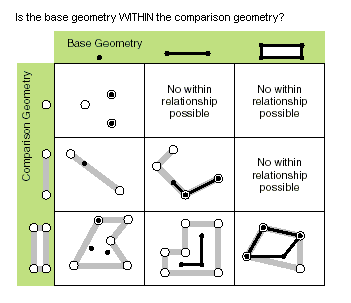Parameters
- geometry1
- The base geometry.
- geometry2
- The comparison geometry.
Return Value
True if geometry1 is within geometry2.
| Exception | Description |
|---|---|
| System.ArgumentNullException | Either geometry1 or geometry2 or both are null. |
| System.NotImplementedException | The method is not implemented for GeometryBag. |
| System.InvalidOperationException | Incompatible spatial references between the input geometries. |
If the geometry2 is empty, then geometry1 is not within geometry2.
If geometry1 is empty and geometry2 is not empty, then geometry1 is within geometry2.
Within is the opposite of Contains. That is, geometry1 is within geometry2 if and only if geometry2 contains geometry1.

/// <summary> /// The methods retrieves the outer ring(s) of the input polygon. /// </summary> /// <param name="inputPolygon">Input Polygon.</param> /// <returns>The outer most (exterior, clockwise) ring(s) of the polygon. If the input is null or empty, a null pointer is returned.</returns> public Polygon GetOutermostRings(Polygon inputPolygon) { if (inputPolygon == null || inputPolygon.IsEmpty) return null; List<Polygon> internalRings = new List<Polygon>(); // explode the parts of the polygon into a list of individual geometries // see the "Get the individual parts of a multipart feature" // snippet for MultipartToSinglePart var parts = MultipartToSinglePart(inputPolygon); // get an enumeration of clockwise geometries (area > 0) ordered by the area var clockwiseParts = parts.Where(geom => ((Polygon)geom).Area > 0) .OrderByDescending(geom => ((Polygon)geom).Area); // for each of the exterior rings foreach (var part in clockwiseParts) { // add the first (the largest) ring into the internal collection if (internalRings.Count == 0) internalRings.Add(part as Polygon); // use flag to indicate if current part is within the already selection polygons bool isWithin = false; foreach (var item in internalRings) { if (GeometryEngine.Instance.Within(part, item)) isWithin = true; } // if the current polygon is not within any polygon of the internal collection // then it is disjoint and needs to be added to if (isWithin == false) internalRings.Add(part as Polygon); } PolygonBuilderEx outerRings = new PolygonBuilderEx(); // now assemble a new polygon geometry based on the internal polygon collection foreach (var ring in internalRings) { outerRings.AddParts(ring.Parts); } // return the final geometry of the outer rings return outerRings.ToGeometry(); }
// build a polygon List<MapPoint> pts = new List<MapPoint>(); pts.Add(MapPointBuilderEx.CreateMapPoint(1.0, 1.0)); pts.Add(MapPointBuilderEx.CreateMapPoint(1.0, 2.0)); pts.Add(MapPointBuilderEx.CreateMapPoint(2.0, 2.0)); pts.Add(MapPointBuilderEx.CreateMapPoint(2.0, 1.0)); Polygon poly = PolygonBuilderEx.CreatePolygon(pts); // an inner point MapPoint innerPt = MapPointBuilderEx.CreateMapPoint(1.5, 1.5); bool within = GeometryEngine.Instance.Within(innerPt, poly); // within = true // point on a boundary within = GeometryEngine.Instance.Within(pts[0], poly); // within = false // an interior line MapPoint innerPt2 = MapPointBuilderEx.CreateMapPoint(1.25, 1.75); List<MapPoint> innerLinePts = new List<MapPoint>(); innerLinePts.Add(innerPt); innerLinePts.Add(innerPt2); Polyline polyline = PolylineBuilderEx.CreatePolyline(innerLinePts); within = GeometryEngine.Instance.Within(polyline, poly); // within = true // a line that crosses the boundary MapPoint outerPt = MapPointBuilderEx.CreateMapPoint(3, 1.5); List<MapPoint> crossingLinePts = new List<MapPoint>(); crossingLinePts.Add(innerPt); crossingLinePts.Add(outerPt); polyline = PolylineBuilderEx.CreatePolyline(crossingLinePts); within = GeometryEngine.Instance.Within(polyline, poly); // within = false // polygon in polygon Envelope env = EnvelopeBuilderEx.CreateEnvelope(innerPt, innerPt2); within = GeometryEngine.Instance.Within(env, poly); // within = true
Target Platforms: Windows 11, Windows 10